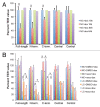PLEKHA7 modulates epithelial tight junction barrier function
- PMID: 24843844
- PMCID: PMC4022608
- DOI: 10.4161/tisb.28755
PLEKHA7 modulates epithelial tight junction barrier function
Abstract
PLEKHA7 is a recently identified protein of the epithelial zonula adhaerens (ZA), and is part of a protein complex that stabilizes the ZA, by linking it to microtubules. Since the ZA is important in the assembly and disassembly of tight junctions (TJ), we asked whether PLEKHA7 is involved in modulating epithelial TJ barrier function. We generated clonal MDCK cell lines in which one of four different constructs of PLEKHA7 was inducibly expressed. All constructs were localized at junctions, but constructs lacking the C-terminal region were also distributed diffusely in the cytoplasm. Inducible expression of PLEKHA7 constructs did not affect the expression and localization of TJ proteins, the steady-state value of transepithelial resistance (TER), the development of TER during the calcium switch, and the flux of large molecules across confluent monolayers. In contrast, expression of three out of four constructs resulted both in enhanced recruitment of E-cadherin and associated proteins at the apical ZA and at lateral puncta adherentia (PA), a decreased TER at 18 h after assembly at normal calcium, and an attenuation in the fall in TER after extracellular calcium removal. This latter effect was inhibited when cells were treated with nocodazole. Immunoprecipitation analysis showed that PLEKHA7 forms a complex with the cytoplasmic TJ proteins ZO-1 and cingulin, and this association does not depend on the integrity of microtubules. These results suggest that PLEKHA7 modulates the dynamics of assembly and disassembly of the TJ barrier, through E-cadherin protein complex- and microtubule-dependent mechanisms.
Keywords: PLEKHA7; barrier; cingulin; epithelium; microtubules; paracingulin.
Figures







References
-
- Powell DW. Barrier function of epithelia. Am J Physiol. 1981;241:G275–88. - PubMed
LinkOut - more resources
Full Text Sources
Other Literature Sources
Research Materials
